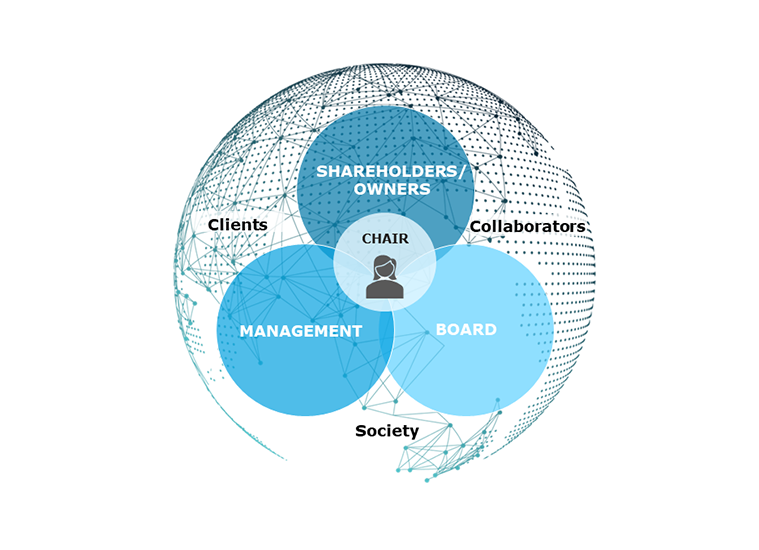Key traits you should master in order to effectively chair your directors through the future challenges of corporate boards.

Corporate boards are under imminent pressure to adapt to global business trends, yet boardrooms remain the most adverse body to change within any organization. Topics such as director diversity, company’s current performance, digital disruption, sufficient board refreshment and relationships with the CEO and shareholders are some of the key areas that investors and chairs around the world are turning their attention to today1. As directors begin to confront these threats, the role of the board chair becomes increasingly significant to ensure the organization’s success.
Only a handful of studies across the world have explicitly focused on the role of the chair in driving change and improving board effectiveness. Using the selected studies as benchmarks, we at Boyden Finland partnered with DIF to take a closer look to see if and how this mindset transformation amongst board chairs is taking place on a local level. We compiled insight on the roles of Finnish board chairs by evaluating companies’ strategic focus, board structures, established processes, characteristics of chairs, as well as the impact of strategic succession planning in ensuring prosperous board leadership. The study included structured interviews with owners, major shareholders and chairs. To set the foundation for the interviews an on-line survey for all DIF members was conducted.
Together with our findings and insights from the leading global studies, we compiled five key characteristics that board chairs should master in order to steer their directors into more efficient decision making in boardrooms. This article focuses on three key traits related to leadership and relationship-building.
1. Becoming the enabler
Vast majority of board chairs have CEO backgrounds, so their focus tends to be on actions and results. Often paired with a hunger for success, this type of “CEO activism” is actually counterproductive in board work2. In order to become a successful board leader, the chair must be able to switch gears and approach the management of the board in a more strategic and observant manner. The role of the chair should be focused around preparing the arena for the directors, not the chair, to produce and execute great decisions.
A good chair leverages past leadership experience by exercising discretion whilst identifying opportunities and carefully guiding the directors to focus on strategy and vision. A skilled chair does not waste time in improving the board dynamics through team-building but utilizes the directors’ capabilities and resources available to maximize effective decision-making.
2. Making way for inclusive collaboration
One of the vital tasks of a chair is to establish a productive and welcoming dynamic within the boardroom. An effective chair is perceptive and has the social competence to navigate around the group dynamics to facilitate more productive discussions. A well-functioning board is led by a person who embraces integrity and trust, someone who understands that as a cohesive group, the board is able to deliver more actionable, strategic results than as individuals.
An effective chair understands that s/he must become a facilitator, not a driver, of strategic discussion and decision-making4. By taking a step back during discussions and ideation, the chair gives the group room to be more creative. At times, the chair needs to exercise constructive challenging of thoughts to attract new ideas and approaches. Constructive challenging should also extend to the interactions with the CEO and the upper management.
3. Building beyond the boardroom
Majority of the integral relationship building occurs outside meeting hours and requires the chair to be accessible and passionate. The chair should seek active engagement from the directors outside the boardroom to attract higher involvement during the meetings. As a leader, the chair needs to find a way to spread motivation and commitment amongst the directors.
Traditionally, board chairs have been using resources to enhance the relationship between the CEO and themselves. We agree with Stanislav Shekshnia, that a good chair understands that it is more important to think of a prosperous CEO-board relationship instead3. A good chair gladly steps away from the spotlight and understands responsibility to serve as the voice for the entire board4. An active internal dialogue with the directors, executives and shareholders provides the board with the information needed to create a holistic understanding of the state of the company.
A good chair works with the board to ensure that informational symmetry exists with the management and the shareholders5. A well-maintained relationship must extend to the owners of the company and is achieved by demanding transparency and accountability from all stakeholders. It is vital for the chair to establish a leadership environment where decisions are made with the highest possible understanding of each issue at hand. The chair must also guide and lead the dialogue between the board and external stakeholders. By also ensuring horizontal movement of information, the board can build relationships with clients, collaborators and the society.
This article is a summarized version of the full article that is published in Boardview-magazine 2/2019.
References:
1 Spencer Stuart, U.S. Board Index 2017; Kauppakamari, Kauppakamareiden PK-hallitusbarometri 2019
2–3 Harvard Business Review, Shekshnia, S., 2018
4–5 INSEAD, Board Chairs’ Practices across Countries, 2016


